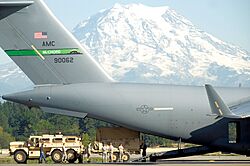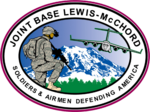Joint Base Lewis–McChord facts for kids
Quick facts for kids Joint Base Lewis–McChord |
|||||||||
|---|---|---|---|---|---|---|---|---|---|
| Near Lakewood, Washington in the United States of America | |||||||||

A C-17A Globemaster III of the 62nd Airlift Wing loading army personnel at Joint Base Lewis-McChord, with Mount Rainier in the background.
|
|||||||||
 |
|||||||||
|
Location in the United States
|
|||||||||
| Coordinates | 47°06′21″N 122°33′52″W / 47.10583°N 122.56444°W (Army Base) 47°08′51″N 122°28′46″W / 47.14750°N 122.47944°W (Air Base) |
||||||||
| Type | US military Joint Base | ||||||||
| Site information | |||||||||
| Owner | Department of Defense | ||||||||
| Operator | United States Army | ||||||||
| Controlled by | US Army Installation Management Command (IMCOM) | ||||||||
| Condition | Operational | ||||||||
| Site history | |||||||||
| Built | 1917 (as Fort Lewis) and 1927 (as Tacoma Field) | ||||||||
| In use | 2010 (as Joint Base) | ||||||||
| Garrison information | |||||||||
| Current commander |
Colonel Phil Lamb (US Army) | ||||||||
| Garrison |
|
||||||||
| Airfield information | |||||||||
| Identifiers | IATA: TCM, ICAO: KTCM, FAA LID: TCM | ||||||||
| Elevation | 98.1 metres (322 ft) AMSL | ||||||||
|
|||||||||
| Other Facilities | See Gray Army Airfield for its airfield data. | ||||||||
Joint Base Lewis–McChord (JBLM) is a huge U.S. military base located near Tacoma, Washington. It's special because it combines two important military sites: Fort Lewis (for the U.S. Army) and McChord Air Force Base (for the U.S. Air Force). They officially joined together on February 1, 2010.
JBLM is a very important place for training soldiers and airmen. It's also where they get ready to go on missions around the world. It's the only Army base west of the Rocky Mountains that can quickly send out large groups of soldiers and their equipment. Its location near major ports like Tacoma and Seattle helps with this. Air Force units at JBLM use large C-17 Globemaster III planes for combat and humanitarian missions.
Contents
Fort Lewis: Army Home
Fort Lewis is a major part of JBLM. It's an Army base located south of Tacoma, Washington. It was named after Meriwether Lewis, famous from the Lewis and Clark Expedition.
Fort Lewis is one of the largest and most modern Army bases in the United States. It covers a huge area of 87,000 acres. Many Army units are stationed here, including parts of the 2nd Infantry Division and the 1st Special Forces Group (United States).
Fort Lewis Units and Training
The I Corps is a main Army command at JBLM. This group plans and works with other Army units. They are ready to deploy anywhere in the world quickly.
Since 2001, I Corps and Fort Lewis have supported important operations like the Global War on Terrorism. This includes missions in Afghanistan and Iraq. Soldiers from Fort Lewis have served bravely in many places.
Some of the main Army units at Fort Lewis include:
- 7th Infantry Division
- 17th Field Artillery Brigade
- 16th Combat Aviation Brigade
- 593rd Expeditionary Sustainment Command
- 1st Special Forces Group (Airborne)
- 2nd Battalion, 75th Ranger Regiment
McChord Air Force Base: Air Power
McChord Air Force Base (AFB) is the Air Force part of JBLM. It's located in Pierce County, Washington. This base is home to the 62nd Airlift Wing, which focuses on moving people and supplies by air all over the world.
McChord AFB joined Fort Lewis in 2010 to form JBLM. This merger was done to make military operations more efficient and save money.
The 62nd Airlift Wing
The 62nd Airlift Wing (62 AW) is the main Air Force unit at McChord AFB. It has over 7,200 military and civilian staff. Their job is to support combat and humanitarian missions worldwide.
The planes of the 62 AW fly around the globe. They practice airdrops and carry out important missions like resupplying Antarctica.
Air Force Units at McChord
The 62d Operations Group flies the large C-17 Globemaster III transport planes. It includes several airlift squadrons.
Other important Air Force units at McChord Field are:
- Western Air Defense Sector (which helps protect U.S. airspace)
- 22nd Special Tactics Squadron (special operations forces)
- 446th Airlift Wing (Air Force Reserve Command)
History of JBLM
JBLM has a rich history, starting with its two original parts.
Fort Lewis History
In 1916, local business people and voters in Washington helped create a military base near American Lake. This base, first called Camp Lewis, became a key training site for U.S. soldiers during World War I. It was known for being well-managed and cost-effective. In 1927, Camp Lewis was officially renamed Fort Lewis.
During its construction, some land belonging to the Nisqually tribe was taken for use as an artillery field. Tribal members were forced to leave their homes.
Units trained at Fort Lewis played important roles in World War II, fighting in both the Pacific and European areas. The base also held German and Italian prisoners of war. In more recent times, Fort Lewis units participated in operations like Operation Just Cause and the Gulf War.
McChord Air Force Base History
McChord Air Force Base was first called Tacoma Field in 1927. It started as a local airport. In 1938, the U.S. government bought it and renamed it McChord Field. This was in honor of Colonel William McChord, who died in a plane accident.
Before World War II, much of the base was built with help from the Works Projects Administration. McChord Field was vital during World War II, training bomber pilots for missions in Europe and the famous Doolittle Raid. In 1948, it became McChord Air Force Base when the U.S. Air Force became a separate branch of the military.
Since World War II, McChord Air Force Base has been an important airlift base. It has supported many missions, including:
- Transporting supplies (like in Operation Desert Shield)
- Humanitarian aid (like after typhoons in 1992, the eruption of Mount St. Helens in 1980, and Hurricane Katrina in New Orleans)
- Air defense (like military interceptions after the 9/11 attacks)
Fort Lewis and McChord Air Force Base officially merged to form Joint Base Lewis–McChord in 2010. This happened after a government recommendation in 2005.
Geography and Environment
Military bases like JBLM have large protected areas. This makes environmental protection very important. The lands at both Fort Lewis and McChord Air Force Base have been used for important environmental studies.
Using military equipment on the base can sometimes affect natural habitats. However, U.S. military facilities are working hard to protect and preserve the environment.
Joint Base Headquarters
The Joint Base Headquarters (JBHQ) manages JBLM. Their job is to support the military units, their families, and the wider military community. They help soldiers train and prepare for missions. They also aim to make JBLM a great place for soldiers and their families to live.
The JBHQ has an Army commander and an Air Force deputy commander. They oversee many departments that provide services like city maintenance, recreation, family programs, and emergency services.
Some of the main groups within the JBHQ include:
- Directorates of Public Works (for maintenance)
- Logistics (for supplies)
- Family and Morale, Welfare and Recreation (for family support and fun activities)
- Emergency Services (like fire and police)
JBLM also has medical facilities for service members and their families. These include Madigan Army Medical Center, the Okubo Clinic, the Nisqually Clinic, and the McChord Clinic.
In 2015, JBLM was recognized for its improvements. It won a Silver Award in 2012 and Bronze Awards in 2013 and 2014 in the Army Communities of Excellence awards program.
JBLM Overview
JBLM has two main commanders: one from the Army (I Corps) and one from the Air Force (62nd Airlift Wing). More than 45,000 service members and civilian workers are part of JBLM. The base also supports over 120,000 military retirees and more than 29,000 family members. This makes JBLM one of the largest military bases in the world by population, with nearly 210,000 people connected to it.
JBLM has four main areas: Lewis Main, Lewis North, McChord Field, and Yakima Training Center. Lewis Main, Lewis North, and McChord Field cover over 86,000 acres. The Yakima Training Center is even larger, covering 324,000 acres.
The base has many high-quality training areas, including 115 live-fire ranges. The Yakima Training Center offers even more space for training and live-fire exercises.
In 2009, the base's correctional facility was updated and renamed the Northwest Joint Regional Correctional Facility (NWJRCF). It holds minimum and medium-security prisoners from all branches of the U.S. Armed Forces.
Camp Murray of the Washington National Guard is also next to JBLM.
Images for kids






